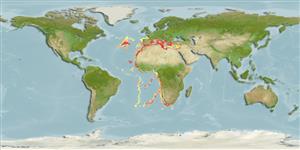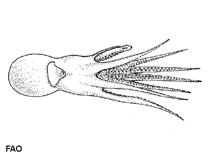Bathypolypus sponsalis (Fischer & Fischer, 1892)
Globose octopus| Native range | All suitable habitat | Point map | Year 2050 |

|
| This map was computer-generated and has not yet been reviewed. |
| Bathypolypus sponsalis AquaMaps Data sources: GBIF OBIS |
Classification / Names প্রচলিত নাম সমূহ | প্রতিনাম সমূহ | CoL | ITIS | WoRMS
Cephalopoda | Octopoda | Octopodidae | Bathypolypodinae
Environment: milieu / climate zone / গভীরতার পরিসীমা / distribution range বাস্তুসংস্থান
ব্যথিডিমারসাল সমুদ্র তলদেশবিহারী; গভীরতার পরিসীমা 200 - 2300 m (সূত্র 104052), usually 400 - 700 m (সূত্র 1958). Subtropical; 12°C - ? (সূত্র 1964)
Distribution দেশ সমূহ | এফ এ ও এলাকাসমূহ | বাস্তুতন্ত্র | দৃষ্টিগোচর | প্রচলন
Eastern Atlantic and the Mediterranean: Iberian Peninsula from Bay of Biscay to Cape Verde.
Length at first maturity / আকৃতি / Weight / Age
পরিপক্কতা : Lm ? range ? - ? cm Max length : 10.0 cm ML পুরুষ/ লিঙ্গ অনিধর্ারিত ; (সূত্র 104052)
Life cycle and mating behavior পরিপক্কতা | প্রজনন | ডিম ছাড়া | Eggs | ডিম্বধারন ক্ষমতা | Larvae
Main reference
সূত্র সংখ্যা | সমম্বয়কারী | সহযোগী
Quetglas, A, M. Gonzales, A. Carbonell and P. Sánchez 2001 Biology of the deep-sea octopus Bathypolypus sponsalis (Cephalopoda: Octopodidae) from the wetern Mediterranean Sea. Mar. Biol. 138:785-792. (সূত্র 1958)
IUCN Red List Status
(সূত্র 130435: Version 2025-1)
CITES status (সূত্র 108899)
CMS (সূত্র 116361)
Threat to humans
Human uses
| FishSource |
হাতিয়ার
আরো তথ্য
Max. ages / sizes
Length-weight rel.
Length-length rel.
Length-frequencies
Mass conversion
প্রাচুর্য
ইন্টারনেট সুত্র
BHL | BOLD Systems | CISTI | DiscoverLife | FAO(Publication : search) | Fishipedia | GenBank (genome, nucleotide) | GloBI | Gomexsi | Google Books | Google Scholar | Google | PubMed | জীবন বৃক্ষ | Wikipedia (Go, অনুসন্ধান ) | জুলজিকাল রেকর্ড



